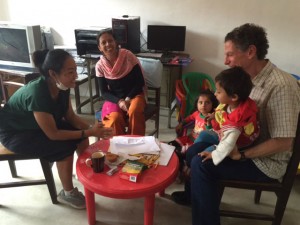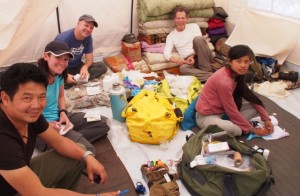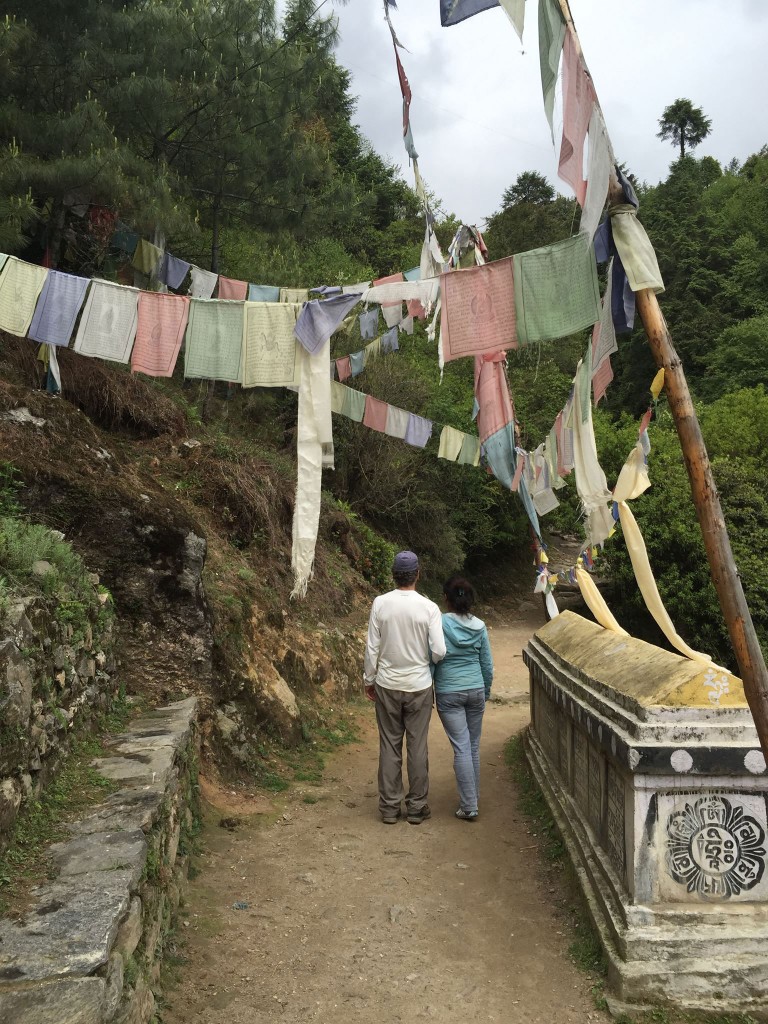The 10 days that Jeffrey Kottler spent in earthquake-ravaged Nepal this month were exhausting and painful but also some of the most worthwhile work of his career, he says.
Kottler served in a medical team with Empower Nepali Girls (ENG), the nonprofit he founded 15

years ago. The help the team members provided, including treating both physical and mental wounds and distributing donated supplies such as tents, is just a “drop in the bucket” toward what is needed, says Kottler, an American Counseling Association member and professor of counseling at California State University Fullerton.
Over the course of 10 days, the ENG team treated more than 500 people, including some in the hardest-hit areas of the country that had yet to see international aid. A 7.8-magnitude quake left much of Nepal in ruins on April 25; the destruction was made worse by a 7.3-magnitude quake on May 12.
Kottler is CEO of ENG, a nonprofit that develops mentoring and supportive relationships with children at greatest risk of being forced into early marriage or sex slavery.

Counseling Today has posted a series of online articles about the conditions in Nepal via Kottler’s travel journals. This journal entry from May 19 is the final installment.
Find more photos and information in earlier articles here and here.
Jeffrey Kottler’s travel journal: May 19
Mount Everest area
I had already seen four families in a row without a break, and my energy was faltering. Many cases are similar: One or more of the children has a headache or stomachache or sleep problem, and the parents are worried; or an adult is hypervigilant and overreactive to any noise or movement, unable to sleep or eat; or some preexisting medical condition like hypertension or heart problems are now far more serious. With such a long line of people waiting to be seen, most of our sessions are 20

minutes. During that time my team of students and I have to figure out what’s going on and attempt some form of reassurance or intervention. I’ve been teaching deep breathing, a simplified form of self-talk, but mostly explaining and normalizing their reactions as typical of trauma symptoms and chronic, unrelenting fear.
One mother brought in her boy after seeing our doctor because of an eating disorder. She had taken him to hospitals trying to figure out why he wouldn’t eat and complained of stomachaches when he did eat. The doctors recommended giving him vitamins and energy drinks to maintain his nutrition. But the mother was beside herself with worry and didn’t know what to do, especially since the earthquakes, when the boy had become even more unwilling to eat at the family meals.
I asked the social work students to do an assessment while I worked with an older girl, one of our [ENG] scholarship students who wanted to attend medical school next year but whose father thought that it was time for her to be married now that she was 18. He insisted girls didn’t belong in school and tried to sabotage her studies as much as he could. What should she do? Can she disobey her father and pursue her studies? Or should she follow her dreams and risk being disowned? I had spoken to her a few months earlier when I was in Nepal with several of my counseling students and had told her that the choice was hers and promised her that if she wanted to continue medical training, we would provide alternative housing and support her. I had directed my counseling students (after only one semester) to talk to her, and one student, Karla, shared her own story of immigrating from Mexico when she was 12, unable to speak English, leaving everything behind, and also showing resolve to be the first in her family to ever attend university, much less graduate school. This seemed to strongly impact the girl, and now I was following up with her.
I returned to our therapy room to find the social work students still trying to engage the boy who would not speak and deferred all questions to his mother. Yes, in other ways he is normal and happy, although since the earthquakes his eating problems have worsened. Yes, the family is intact and they are all healthy. Yes, their home had been damaged and they were living outside, but they planned to move back inside if there were no further quakes in the next few days. The students looked at me and shrugged, unsure what to do next. They are smart and capable and awesome, but this was really confusing, and I was also puzzled. Time was running short, and we had barricaded the door against the crowd fighting to get their turn.
I told the boy I had a test for him and wondered if he would pass. He looked intrigued, so I told him that I bet I could find something that he would eat. He barely looked at me, but I could see the beginning of a smile. I pulled out a Snickers bar and handed it to him. Out of pure obstinacy, he

shrugged and passed it to his mother, pretending he wasn’t interested. He looked back at me defiantly, the glimpse of a smile now gone.
“What DO you like to eat?” I asked him. “Smoothies?”
He nodded his head affirmative, or rather waggled it back and forth in that characteristic Nepali way.
“KFC?”
Another nod.
“Kabobs?”
Again, a nod.
“So, what don’t you like to eat?”
He whispered something I couldn’t hear. “Say that again,” I asked him.
“Dahl baht.”
“I see.” And now I did see. Most Nepalis eat rice and lentils for both meals of the day, every day, even when they are given other choices. It is perhaps the single most nutritious meal that the human body can metabolize and provides a cheap and efficient source of protein and energy. It turned out he really didn’t have an eating disorder; he just didn’t like dahl baht. But he LOVED fast food.
My head hurt with concentration. I desperately needed a break and to use the restroom. Before I could get out of my chair, a tiny girl was carried into the room by a man, accompanied by what I assumed was the girl’s mother. They were followed by the principal of the school we were using as our clinic, and Pasang Sherpa, the president of our (ENG) foundation in Nepal.
Because confusion was my usual state of mind, I just sat and waited for the drama to unfold. I wondered what could possibly surprise me next.
“This is Pramisa,” Pasang said to me, pointing to this absolutely adorable girl who was looking around the room, studying all of us carefully. “She is 3 years old.”
I nodded, waiting. Pasang and the principal explained to me that these were her aunt and uncle.
“Where are her parents?” I asked.
Everyone looked at one another after the translation. Her mother was at the hospital. “She is dressed in white,” the uncle said.
“She is dressed in white?” I repeated, now completely confused.
“Yes,” Pasang agreed. “Her husband, the girl’s father, died yesterday. He was hit on the head during the last earthquake. He was in the hospital and he died. The mother is with the body, dressed in white as she is [culturally] required. This girl, she doesn’t have a father, and we haven’t told her yet.”
I looked at this little girl, Pramisa, and she was smiling and playing with a stuffed animal I had just given her. My heart just broke. I could feel myself losing control, tears running down my cheeks, and so excused myself for a moment and walked out of the room to regain my composure. Were we now going to tell this 3-year-old that her father was never coming home? I had already seen and done so much, but this I could not do. But I knew I had to go back in the room.
Once I was back in my chair, Pasang asked if we might offer this girl a scholarship, support her now that she had lost her father and her home. They had no money, no place to live, no way to earn an income. The mother would spend a year in mourning, and that would be her job.
I thought to myself how fate had put me in this place, at this moment in time. My chest hurt. I felt so flooded with emotion from all the accumulated stress, all the stories I had heard and all the people I
had seen. I had felt so helpless at times, so inadequate to provide the help and support that everyone needed. And now I was given this gift: I could save this child — literally save her life and give her a future — by agreeing to provide her with a scholarship so she could have an education and a future.
I could barely speak, but I nodded my head, once, twice, then up and down so vigorously that everyone looked at me curiously. “Yes, of course,” I finally spoke aloud. I looked at the aunt and uncle and told them that although this was a terrible tragedy, I would do everything in my power to make certain that Pramisa was provided an education, to go as far as she could in life, maybe even to become a doctor or an engineer, professions that were rarely possible for girls in Nepal.
Then I fled the room, went into the restroom, shut the door and started sobbing. In fact, I am crying now as I try to tell this story.

We are now heading home after 10 days of exhausting, overwhelming work. During this time, we have treated more than 500 patients, as well as distributed and prescribed $30,000 worth of medications and medical supplies that have been donated by doctors and hospitals in the U.S. We reached areas that have still not received any government help or assistance by any nongovernmental organization three weeks after the first earthquake.
It has been among the most painful and yet the most interesting experiences of my professional life. I have known many of our ENG scholarship girls for over 10 years, some for almost 15 years. During that time I have spent time with their families, shared tea in their homes, visited with them at school and walked on the trails, listened to the stories of their lives and the daily challenges they face. Now many of their homes are destroyed. Their schools are gone and their teachers have disappeared.
My heart still hurts. I can barely sleep. I’ve probably lost 10 pounds in the last week. I can’t tighten my belt any farther. I know this is the result of compassion fatigue or vicarious trauma, as well as primary trauma of surviving two major earthquakes and dozens of smaller ones. I know it is the result of working insane hours and seeing so many people compressed in a day. I know it is the result of seeing so much devastation and despair, so much sickness.
I know that what we have done is just a drop in the bucket compared to the millions of people who still need help, need tents and food and water, need support. But after a life devoted to service, a life dedicated to teaching and helping others, I am certain that everything I have ever done, everything I have ever prepared for, was to be here now.

****
For more information on Empower Nepali Girls, see empowernepaligirls.org
See recent photos and updates from Nepal at ENG’s Facebook page
****
Bethany Bray is a staff writer for Counseling Today. Contact her at bbray@counseling.org
Follow Counseling Today on Twitter @ACA_CTonline and on Facebook: facebook.com/CounselingToday

Comments are closed.